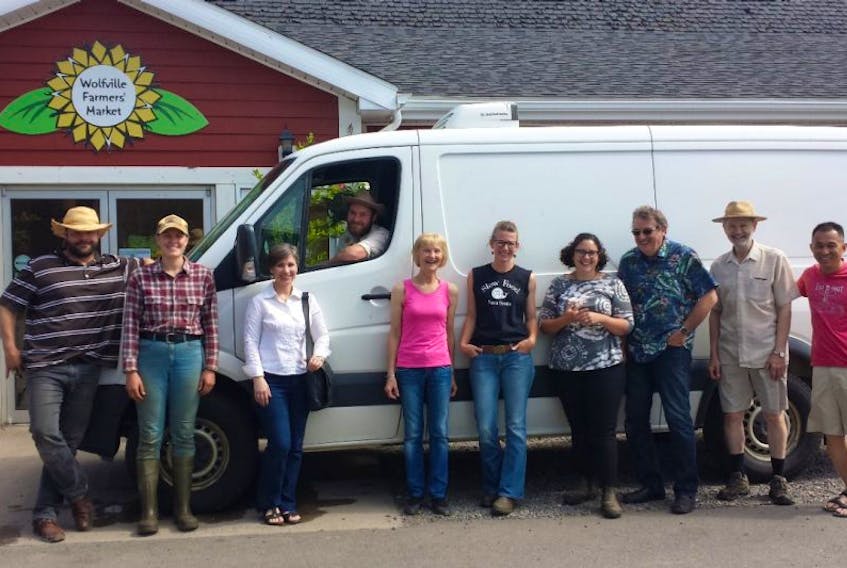Redcliffe says the service is designed to offer convenient access to fresh and local products, while also building a robust local economy and healthy connected communities.
Inaugurating this service with 14 WFM vendors, it will offer approximately 150 products and is in partnering with three Community Hubs in Canning, Berwick and Wolfville.
Customers can choose precisely the products they would like to order with this weekly service, she said.
WFM will offer the service year-round and, Redcliffe noted, is particularly excited to work with the early adopters (vendors, community hubs and customers) throughout each season.
“This new food distribution system has the potential to vastly increase the sustainability of its smaller producers while offering convenience, accessibility and connection for customers who will pay the same prices as those at the brick and mortar Wolfville Farmers’ Market.”
“We are excited about this project because it improves accessibility to local food for more Nova Scotians and because it creates increased opportunities for small farms and businesses to sell their products and grow as local entrepreneurs - something that we feel is an important step for building a more resilient, local economy,” said Jocelyn Durston of Seven Acres Farm.
The website is now ready for customers to sign up for an account. On Wednesday, June 28 at 7 p.m., customers can place orders for the first delivery date of Wednesday, July 5.
When customers shop online they can search by product type or producer, and choose the community location where they would like to pick up their products. The weekly ordering cut off on Monday at 5 p.m. allows enough time for producers to harvest and assemble products according to orders and bring them to the Market on Wednesday afternoons where WFM2Go will organize and then deliver to Community Hubs in Canning and Berwick for Wednesday evening. There will also be an option to pick up at the Wolfville Farmers’ Market itself during the Wednesday Market Suppers.
The community hubs are made up of people and organizations interested in increasing access to fresh local food in their community. Each hub, while offering a pick-up hour for the WFM2Go orders, will have unique programming depending on the needs and assets of their community.
Hub programs or events might include a speakers’ series, opportunities for other local vendors, recipe swaps or sampling demos and Meet the Farmer Days. Depending on the partners involved in each hub, there will be opportunities for community members to donate gift certificates so that others in their community may be given the opportunity to participate as well, to further increase access to fresh and local products.
“I am excited about the opportunity to bring people and communities together and to break another barrier to accessing local agriculture for community members,” said Jennie Weisner rirector of Canning Recreation and the Hub Host for the Canning Community Hub.
“This project has been a long time coming,” said Redcliffe. “We haven’t been able to find any other examples of a farmers’ market launching its own on-line store and delivery service for their community members, but there are many food hubs, community shared agriculture programs and web developers working to help increase access to local food and we are grateful to all those who have blazed this trail and helped us along the way.”
She said, “I am grateful for our vendors who impress me every week with their amazing products and generosity of spirit. In every way this project has been designed with their sincere wish to nourish and better the health of our communities. It’s the kind of success I feel so privileged to be part of and I am very excited by the possibilities.”
Those who wish to become early adopters of this service can read more and sign-up now at: https://wfm2go.localfoodmarketplace.com. There is also a WFM2Go
Facebook Page and Instagram Account for those who want to be part of the WFM2Go Community.
History of the On-line Store
Growth for the WFM and its vendors had been sustainable and constant over the years, however in the last five years, growth for its agri-producers has become more or less stagnant. At the same time, the WFM’s primary producers have become sophisticated marketers, have developed their farms and are poised for growth.
WFM , along with the farmers’ market sector as a whole, has identified that many consumers are treating Farmers’ Markets as a social gathering space where they do not necessarily purchase their groceries. Although Farmers’ Markets are attracting attention, business has levelled off for many producers. Additionally, despite the consumer’s appetite for local purchasing, there are many barriers to purchasing groceries at the local farmers market, including: crowds, the need to use cash, line-ups for every vendor, perception around costs due to use of cash and individualized/segmented purchases, the question of what’s available on any given day, making it to the market during its specific time-frame of operation and its distance from many outlying communities. For some consumers, these are opportunities, which the WFM’s success attests to, but for others these are insurmountable barriers.
Instead of assuming that this was a marketing issue, or that it was time to settle, the WFM began exploring an IT solution to these issues. In 2014, they partnered with HarvestHand, a local software development company, which had created software for Community Shared Agriculture. HarvestHand created a shopping list application for WFM called ‘What’s Fresh’ that enabled each vendor to have an account and input their available products each week. This was successfully trialed for a six month period in which the WFM was able to identify their vendor’s commitment to an IT approach to growth, and their customer’s interest, not so much in what was available at the market, but the opportunity to purchase it. With this experience, the cooperative decided to move forward with an e-commerce platform and worked with another progressive Nova Scotian software developer working to create software for a network of food hubs in an effort to build connection and food security and give communities the resources to gain access to local food. The Hive Market wasn’t quite ready in time for the July launch of WFM2Go, but fortunately, and with the help of its original software partners, the WFM found an off-the-shelf software platform with Local Food Marketplace out of Eugene, Oregon that was designed for food hubs and online stores that deliver.
Through the process of working with software developers, the cooperative learned a lot about what is involved in operating an on-line delivery operation. The process has also given the WFM an opportunity to really explore which model of operation would be best given its strengths (great vendors, a healthy organization, extensive positive partnerships, a trusted brand, and a vision to better the health and vibrancy of communities). The WFM felt it was uniquely positioned to leverage these strengths to do something it saw no other farmers’ market doing, but also something that it could envision others doing.
First Subsequent Year
The WFM has committed to this project year-round for the first year in order to assess its viability through the seasons. During this year, it will assess and increase the number of vendors, Community Hubs and customers according to capacity and growth potential. The market has no intention of stopping at the end of this period, but has committed to 15 months regardless of any potential challenges.
A new Food Distribution Model
This new food distribution model, which builds on the farmers’ market cooperative model, is meant to address the needs and wishes of everyone in the food system. The producers gain new customers to help them build sustainable farms. The WFM diversifies its own income while aggregating and delivering product for its vendors in a sustainable operation. The Community Hubs can build a unique community development opportunity around accessible local food. And, of course, the consumer gets increased service, choice and convenience along with connection and quality fresh local products while paying the same prices for products as those who buy from the brick and mortar Wolfville Farmers’ Market.









